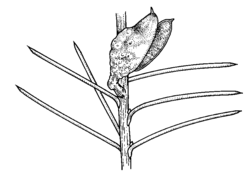Hakea decurrens R.Br. APNI* 
Description: Spreading shrub to small tree 0.3–5 m high, new growth glabrous to sparsely or densely hairy; lignotuber present.
Leaves spreading widely from stem, terete, 1.5–8 cm long, 0.7–1.6 mm diam., rigid, mucro c. 1 mm long, glabrous.
Conflorescences axillary, clusters 1–6-flowered; rachis knob-like, to 3 mm long; pedicels 1–4 mm long, pubescent. Perianth 4–7 mm long, white or sometimes tinged pink, glabrous. Gynoecium 9–12 mm long; pollen presenter an oblique disc.
Follicle ± ovoid, 18–35 mm long, 14–36 mm wide, covered in discrete warts; beak prominent; horns present.
Flowering: Flowers May–September
Distribution and occurrence: In dry sclerophyll forest or woodland or heath, often grows in sandy or rocky situations on the tablelands and on the Slopes, chiefly from the Pilliga Scrub south to Mendooran, the Blue Mtns south to the A.C.T., and coastal districts south from Eden.
NSW subdivisions: SC, CT, ST, NWS, CWS, SWS, NWP
Other Australian states: Vic. Tas. *S.A.
Text by R.M. Barker, G.J. Harden, L. Haegi & W.R. Barker
Taxon concept:
| | Key to the subspecies | |
| 1 | Red-brown wood zone on inner face of fruit valve beside seed cavity at widest point towards base 1–2.5 mm wide; indumentum on branchlets appressed hairy to tomentose, usually quickly glabrescent, sometimes persisting to flowering. | 2 |
| Red-brown wood zone on inner face of fruit valve beside seed cavity at widest point towards base 3–5 mm wide; indumentum on branchlets tomentose, persistent to well after flowering. Follicle ovoid, 26–36 mm wide. | subsp. platytaenia |
| 2 | Follicles ovoid to obovoid, 14–19 mm wide; pale wood zone 3.5–6 mm wide, the outer layer mostly 1–2.5 mm wide. | subsp. decurrens |
| Follicles ovoid to ellipsoid or broadly so, 15–325 mm wide; pale wood zone usually 6–12 mm wide, the outer layer 2.5–5.5 mm wide.
Back to 1 | subsp. physocarpa |
APNI* Provides a link to the Australian Plant Name Index (hosted by the Australian National Botanic Gardens) for comprehensive bibliographic data
***The AVH map option provides a detailed interactive Australia wide distribution map drawn from collections held by all major Australian herbaria participating in the Australian Virtual Herbarium project.
|


